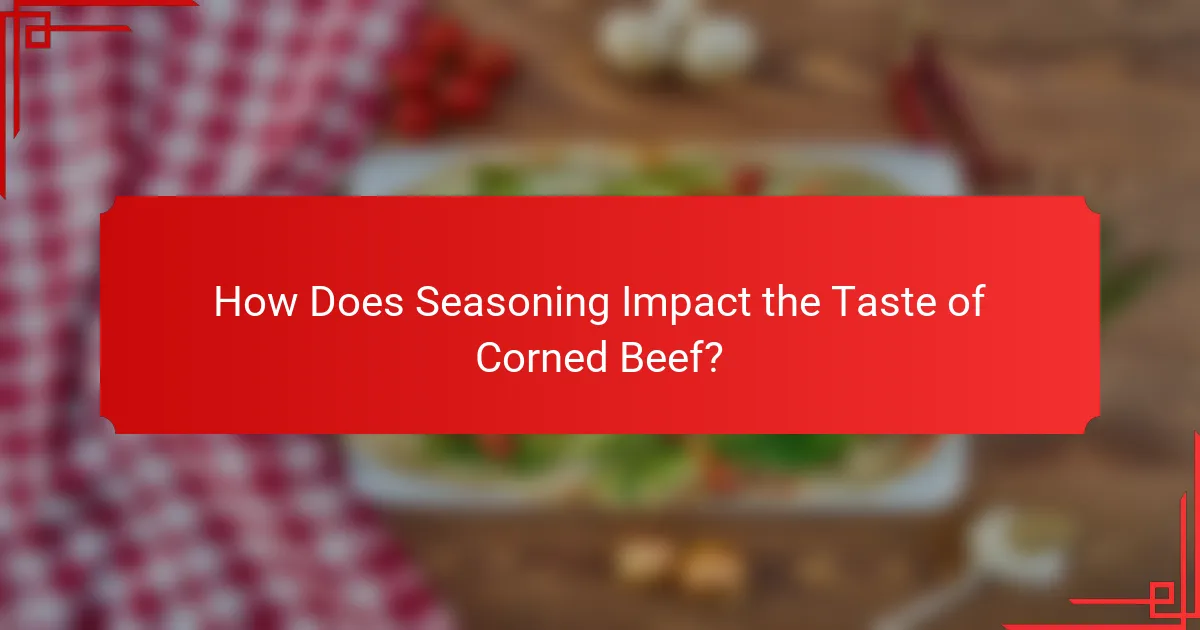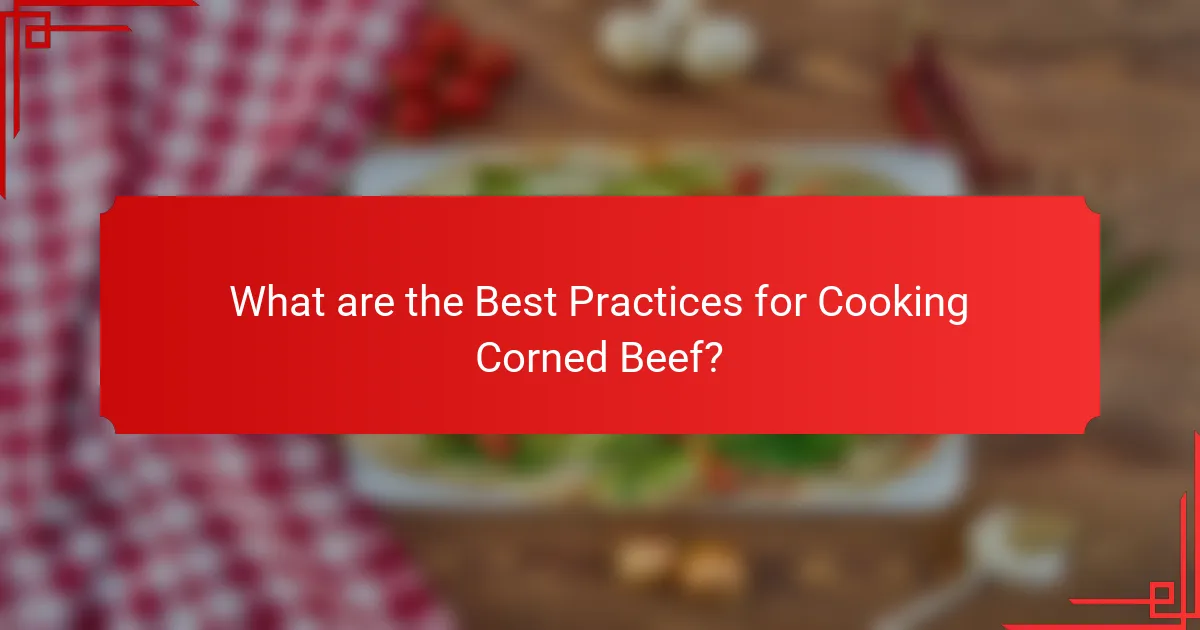
What is the Unique Taste of Corned Beef?
Corned beef has a distinctive taste characterized by its salty, savory flavor profile. This unique taste comes from the curing process, which includes brining the beef in a mixture of salt, spices, and sometimes sugar. Common spices used in this process include coriander, peppercorns, and mustard seeds. The meat’s texture is tender yet firm, resulting from the slow cooking method typically used. When cooked, corned beef develops a rich, hearty flavor that pairs well with various dishes. It is often served with cabbage and potatoes, enhancing its savory qualities. The combination of spices and the curing process creates a flavor that is both robust and comforting.
How is Corned Beef Prepared to Achieve its Unique Flavor?
Corned beef is prepared through a process of curing and seasoning. The meat is typically brined in a solution of water, salt, sugar, and spices. Common spices include black peppercorns, mustard seeds, and coriander. This curing process usually lasts several days to allow the flavors to penetrate the meat. After curing, the corned beef is often simmered or slow-cooked until tender. Cooking it in a flavorful broth can enhance its taste further. The combination of spices and the brining method contributes to its unique flavor profile. Historically, this method of preservation dates back to ancient times, making it a traditional culinary practice.
What are the key ingredients used in corned beef seasoning?
Key ingredients used in corned beef seasoning include salt, black peppercorns, coriander seeds, mustard seeds, and crushed red pepper. Salt is the primary preservative and flavor enhancer. Black peppercorns add a sharp, spicy note. Coriander seeds contribute a citrusy flavor. Mustard seeds provide a tangy taste. Crushed red pepper adds heat. These ingredients are often combined to create a brine that infuses the beef with flavor during the curing process.
How does the curing process influence the taste of corned beef?
The curing process significantly enhances the taste of corned beef. Curing involves soaking the beef in a brine solution, which typically contains salt, sugar, and various spices. This process allows the meat to absorb flavors from the brine. The salt not only preserves the meat but also enhances its natural flavors.
Additionally, spices such as peppercorns, coriander, and mustard seeds contribute unique flavor profiles. The duration of the curing process can also impact taste; longer curing times result in more intense flavors. The interaction between the meat and brine creates a savory, umami-rich taste that is characteristic of corned beef.
Research indicates that the curing process alters the meat’s protein structure, improving tenderness and flavor absorption. This transformation is essential for achieving the desired taste in corned beef.
What Textural Characteristics Define Corned Beef?
Corned beef is characterized by its tender and moist texture. The meat is typically brined, which enhances its juiciness. This process also contributes to a slightly fibrous texture. When cooked, corned beef becomes easily sliceable. The outer layer often has a slightly crispy texture due to the cooking method. The interior remains soft and succulent. These textural characteristics make corned beef versatile for various dishes. The combination of tenderness and moisture is essential for its appeal in culinary applications.
How does the cooking method affect the texture of corned beef?
The cooking method significantly affects the texture of corned beef. Different methods yield varying results in tenderness and moisture retention. Slow cooking methods, such as braising or using a slow cooker, break down collagen in the meat. This results in a tender, melt-in-your-mouth texture. Conversely, high-heat methods like boiling can lead to a tougher texture due to rapid moisture loss.
Sous vide cooking maintains consistent low temperatures, ensuring even cooking and optimal tenderness. Additionally, the duration of cooking directly impacts texture; longer cooking times enhance tenderness. The choice of seasoning and brining also plays a role, as they can influence moisture retention and flavor [censured]. Overall, the selected cooking method is crucial in determining the final mouthfeel of corned beef.
What are the differences in texture between various cuts of corned beef?
Corned beef cuts vary in texture due to their location on the animal and muscle composition. The flat cut, often leaner, has a firmer texture and less marbling. The point cut is fattier and offers a more tender, juicy mouthfeel. The round cut is lean with a slightly tougher texture. The brisket cut, which includes both flat and point, combines both textures, being tender yet with some chew. Each cut’s texture affects cooking methods and flavor absorption. The differences arise from muscle fiber structure and fat content, impacting overall culinary experience.
What Culinary Uses Are Common for Corned Beef?
Corned beef is commonly used in sandwiches, particularly the Reuben sandwich. It is also popular in dishes like corned beef hash, which combines diced corned beef with potatoes and onions. Additionally, corned beef is often served with cabbage, especially during St. Patrick’s Day celebrations. This meat is also used in soups and stews for added flavor. Another culinary use includes incorporating corned beef into breakfast dishes, such as omelets or breakfast burritos. It can also be sliced thinly for charcuterie boards. Corned beef’s versatility makes it a favored ingredient in various cuisines.
How can corned beef be incorporated into traditional dishes?
Corned beef can be incorporated into traditional dishes by using it as a primary protein source or flavor enhancer. It is commonly featured in Irish dishes such as corned beef and cabbage. This dish combines boiled corned beef with cabbage and root vegetables, creating a hearty meal. Corned beef can also be included in sandwiches, notably the Reuben, which pairs it with sauerkraut and Swiss cheese. Additionally, it can be used in hash, where diced corned beef is mixed with potatoes and onions, then pan-fried. In Jewish cuisine, corned beef is often served in deli-style sandwiches, highlighting its savory flavor. These traditional applications showcase corned beef’s versatility and its ability to enhance the overall taste of the dish.
What are some innovative recipes featuring corned beef?
Corned beef can be used in innovative recipes such as corned beef hash, corned beef tacos, and corned beef sliders. Corned beef hash combines diced corned beef with potatoes and vegetables, creating a hearty breakfast dish. Corned beef tacos feature shredded corned beef topped with cabbage and spicy salsa, offering a unique twist on traditional tacos. Corned beef sliders use small buns filled with corned beef, cheese, and pickles, making for a tasty appetizer. These recipes highlight corned beef’s versatility in various culinary applications.

How Does Seasoning Impact the Taste of Corned Beef?
Seasoning significantly enhances the taste of corned beef. It introduces flavors that complement the natural richness of the meat. Common seasonings include black pepper, coriander, and mustard seeds. These ingredients provide a balance between savory and slightly spicy notes.
The curing process uses salt, which also impacts the overall flavor profile. Salt intensifies the meat’s umami taste, making it more savory. Additionally, seasoning can affect the tenderness of corned beef. Properly seasoned meat can become more flavorful and enjoyable when cooked.
Research indicates that the right blend of spices can elevate the eating experience. A study published in the Journal of Food Science found that specific seasoning combinations enhance flavor perception. This shows that seasoning is crucial for maximizing the taste of corned beef.
What Spices are Essential for Flavoring Corned Beef?
Essential spices for flavoring corned beef include black pepper, coriander, mustard seeds, and bay leaves. Black pepper adds a sharp heat that enhances the meat’s flavor. Coriander provides a citrusy note that balances the richness of the beef. Mustard seeds contribute a tangy depth that complements the dish. Bay leaves infuse a subtle herbal aroma during cooking. These spices are traditionally used in brining corned beef, creating a distinctive taste profile. The combination of these spices is rooted in historical recipes, ensuring a flavorful outcome.
How do different spice blends alter the flavor profile of corned beef?
Different spice blends significantly alter the flavor profile of corned beef. Common blends include mustard seed, coriander, and black pepper. Mustard seed adds a tangy kick, enhancing the overall flavor. Coriander contributes a citrusy note, balancing the richness of the meat. Black pepper introduces heat, creating a more robust taste. Other blends may include garlic and bay leaves, which deepen the savory aspects. The combination of these spices can result in variations from sweet and aromatic to spicy and savory. Historical recipes often showcase regional preferences, demonstrating the impact of local spices on corned beef flavor.
What role does salt play in the seasoning of corned beef?
Salt is essential in the seasoning of corned beef. It enhances flavor and preserves the meat. Salt draws moisture out, creating a brine that penetrates the beef. This process helps to tenderize the meat. Additionally, salt contributes to the characteristic taste of corned beef. It balances the spices typically used in the seasoning mix. The curing process involves salt, which also inhibits bacterial growth. This ensures the meat remains safe for consumption during storage.
Why is Marinade Important in Corned Beef Preparation?
Marinade is important in corned beef preparation because it enhances flavor and tenderizes the meat. The marinade typically includes salt, spices, and sometimes sugar. These ingredients penetrate the beef, infusing it with a rich taste. Salt helps in drawing moisture into the meat, making it juicier. The spices, such as coriander and peppercorns, add aromatic notes. Additionally, marinating for several days allows for optimal flavor absorption. This process is crucial as it transforms the beef into the distinctive corned beef product loved in various cuisines.
What are the benefits of marinating corned beef before cooking?
Marinating corned beef before cooking enhances its flavor and tenderness. The marinade infuses the meat with additional spices and seasonings. This process allows the flavors to penetrate deeply into the beef. As a result, the final dish is more flavorful and aromatic. Marinating can also help break down tougher muscle fibers. This leads to a more tender texture after cooking. Additionally, marinating can contribute to moisture retention during the cooking process. This helps prevent the meat from drying out, ensuring a juicy outcome. Overall, marinating improves both taste and texture in corned beef dishes.
How long should corned beef be marinated for optimal flavor?
Corned beef should be marinated for at least 5 to 7 days for optimal flavor. This duration allows the spices and brine to penetrate the meat thoroughly. The process enhances the taste and tenderness of the beef. Longer marination can lead to a more intense flavor profile. It is essential to keep the beef refrigerated during this time to ensure food safety. The salt and spices in the marinade work effectively over this period. This method is commonly used in traditional recipes for corned beef preparation.

What are the Best Practices for Cooking Corned Beef?
The best practices for cooking corned beef include slow cooking, using sufficient liquid, and seasoning appropriately. Slow cooking allows the meat to become tender and flavorful. A common method is to simmer corned beef in water or broth for several hours. This process typically takes about 2.5 to 3 hours for a 3 to 4-pound brisket.
Adding spices like bay leaves, peppercorns, and mustard seeds enhances the flavor. It is also beneficial to add vegetables such as carrots and potatoes during the last hour of cooking. Checking the internal temperature is crucial; it should reach at least 145°F for safety.
Resting the meat for 10 to 15 minutes after cooking allows juices to redistribute. Slicing against the grain ensures the meat remains tender. Following these practices results in a delicious and well-cooked corned beef.
How Can You Ensure Tenderness in Corned Beef?
To ensure tenderness in corned beef, cook it slowly at a low temperature. This method allows the collagen in the meat to break down, resulting in a more tender texture. Braising or simmering the corned beef for several hours is effective. Aim for an internal temperature of at least 190°F to achieve optimal tenderness. Using a meat thermometer can help monitor this. Additionally, resting the meat after cooking allows the juices to redistribute, enhancing tenderness. Slicing against the grain also contributes to a more tender bite. These techniques are supported by culinary practices that emphasize low and slow cooking for tougher cuts of meat.
What cooking methods yield the most tender corned beef?
Slow cooking and braising yield the most tender corned beef. These methods involve cooking the meat at low temperatures for extended periods. Slow cooking allows the collagen in the beef to break down, resulting in a softer texture. Braising combines both moist and dry heat, which enhances tenderness. Cooking corned beef in a liquid, such as broth or beer, further contributes to its juiciness. Pressure cooking is also effective. It significantly reduces cooking time while maintaining tenderness. These methods are widely recommended by culinary experts for achieving optimal results.
How does cooking time affect the tenderness of corned beef?
Cooking time significantly affects the tenderness of corned beef. Longer cooking times break down the connective tissues in the meat. This process results in a more tender texture. Typically, corned beef should be cooked for at least 2.5 to 3 hours. Cooking at a low temperature helps maintain moisture and tenderness. The ideal internal temperature for tender corned beef is around 190°F. At this temperature, collagen converts to gelatin, enhancing tenderness. Studies show that overcooking can lead to dryness, while proper timing yields a juicy result.
What Tips Can Enhance the Flavor of Corned Beef Dishes?
To enhance the flavor of corned beef dishes, consider using a variety of spices and herbs. Adding black peppercorns, mustard seeds, and coriander can deepen the taste. Incorporating aromatics like garlic and onion during cooking also enriches the flavor profile. Cooking corned beef slowly in a flavorful broth or with vegetables can infuse additional tastes. Additionally, marinating the meat before cooking can allow the flavors to penetrate more deeply. For finishing touches, serving with tangy sauces or pickles can complement the dish effectively. These methods are supported by culinary practices that emphasize seasoning and slow cooking for optimal flavor extraction.
How can you pair corned beef with sides for a balanced meal?
Pair corned beef with sides like vegetables and whole grains for a balanced meal. Pairing with steamed broccoli or carrots adds fiber and vitamins. Incorporating potatoes, either mashed or roasted, provides carbohydrates. Whole grain bread or a salad can enhance the meal’s nutritional value. Aim for a variety of colors on the plate to ensure a range of nutrients. This combination supports a balanced intake of proteins, carbs, and vitamins.
What are some common mistakes to avoid when cooking corned beef?
One common mistake to avoid when cooking corned beef is not rinsing it before cooking. Rinsing removes excess salt and brine, which helps prevent an overly salty dish. Another mistake is cooking at too high a temperature. High heat can lead to tough, dry meat. Instead, low and slow cooking is recommended for tenderness.
Failing to allow the meat to rest after cooking is another error. Resting helps redistribute juices, enhancing flavor and moisture. Additionally, cutting the meat against the grain is crucial for better texture. Slicing with the grain can result in a chewier bite.
Not using enough liquid during cooking can dry out the corned beef. The meat should be submerged in broth or water for optimal results. Finally, ignoring the recommended cooking time can lead to undercooked or overcooked meat. Following package instructions ensures proper doneness and flavor.
Corned beef is the primary entity explored in this article, highlighting its unique taste characterized by a salty, savory flavor profile resulting from a specific curing process. Key attributes include the essential ingredients used in seasoning, such as salt, black peppercorns, and coriander, which significantly influence the flavor and texture of the meat. The article examines the preparation methods, including marination and cooking techniques, that enhance tenderness and overall culinary applications, such as in sandwiches and traditional dishes. Additionally, it addresses common mistakes to avoid when cooking corned beef to achieve optimal results.